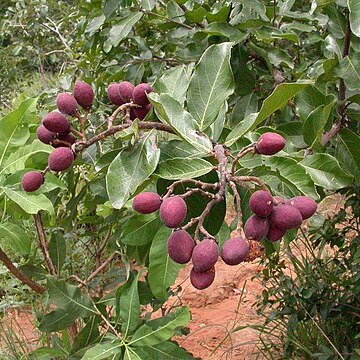Ovary superior, basically of 3 carpels and gynobasic but usually with only 1 carpel fully developed, attached to base, middle or mouth of receptacle-tube, sessile or on a short gynophore, always hairy, each carpel 1-locular with 2 ovules, or 2-locular, owing to a false septum, with 1 ovule in each compartment; style filiform; stigma distinctly or indistinctly 3-lobed
Stamens 2–100 or more, included or exserted, inserted in 1 or 2 rows on the margin of the disk or adnate to its abaxial surface, either all fertile and forming a complete circle or partly staminodial; filaments free or appearing connate at the base or (not in our area) ligulately connate; anthers small, 2-thecous, dehiscing longitudinally
Receptacle-tube short to elongate, straight or curved, often gibbous at the base, always lined with nectariferous tissue which is extended at the throat as a short annular disk; throat at least partly blocked by long hairs
Fruit a dry or fleshy drupe; endocarp thick or thin, fibrous, granular or bony, often with a special mechanism for seedling escape, often densely hairy inside
Leaves simple, entire, alternate, often coriaceous, usually with two glands at base of lamina or near apex of petiole
Flowers mostly (in our area always) bisexual, actinomorphic to zygomorphic, strongly perigynous
Petals 5, rarely absent (not in our area), sometimes unequal, imbricate, often caducous
Germination hypogeal or epigeal; first leaves of seedling opposite or alternate
Seed erect, exalbuminous; cotyledons plano-convex, fleshy, sometimes ruminate
Sepals 5, free, imbricate, often unequal, ascending or reflexed
Stipules small and caducous to large and persistent
Trees, shrubs or rhizomatous, geoxylic suffrutices
Wood always with abundant silica inclusions
Inflorescence a cyme, panicle or raceme

